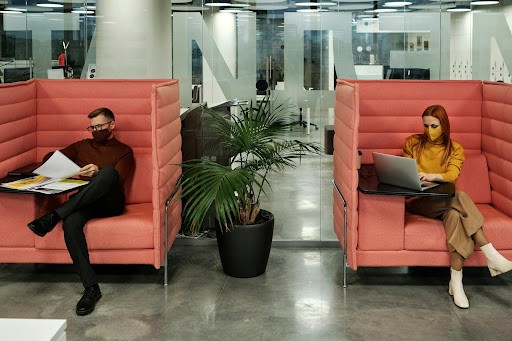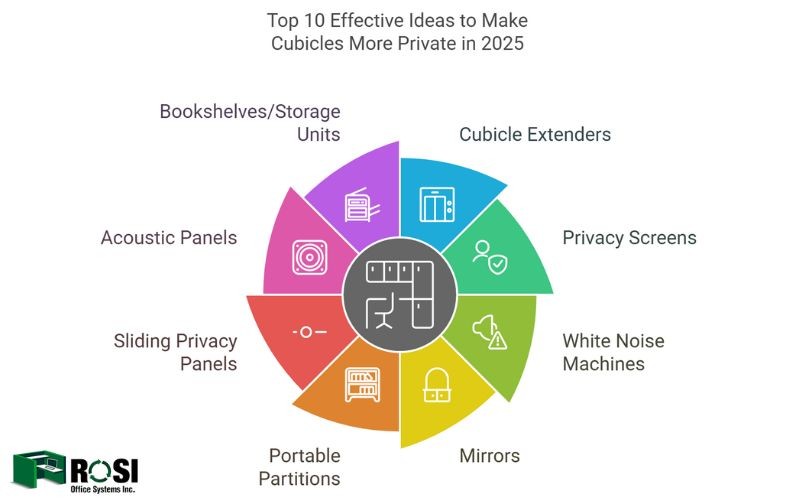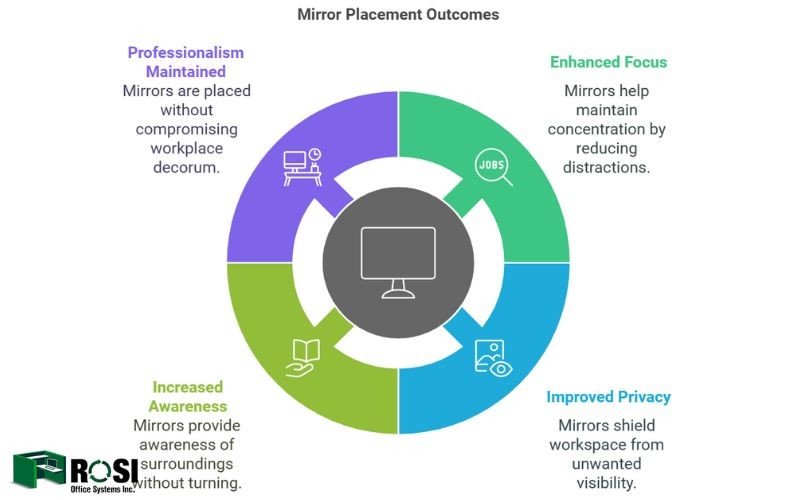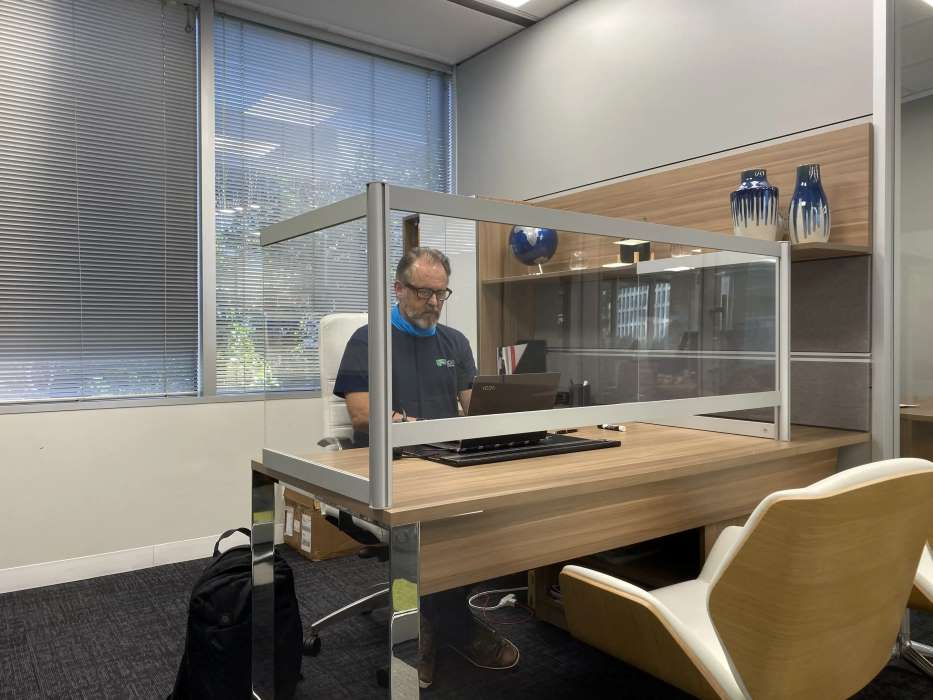
Would you like more privacy in your office space? Is your workspace partitioned with cubicles?
Here are 10 effective ideas to make your office cubicles more private.
Enhance cubicle privacy in 2025 with creative and effective solutions. Add cubicle extenders to raise walls and block distractions, or use privacy screens for a semi-enclosed workspace.
White noise machines mask background chatter for a quieter environment, while strategically placed mirrors provide awareness and comfort. Portable partitions offer flexibility to adjust your workspace as needed.
Personalize your cubicle with plants to absorb sound and create natural barriers, or try noise-canceling curtains for an extra layer of quiet. Desk shades and canopies shield your space from prying eyes, and creative storage solutions like shelving add function and separation.
Let’s explore these 10 ideas comprehensively:

1. Use Cubicle Extenders for Enhanced Height and Privacy
The most impactful way to improve privacy in an open office is by adding cubicle extenders. Attach the panels to the top of your existing cubicle walls to increase their height and reduce visibility into your workspace.
Cubicle extenders are made of various materials including fabric, frosted glass, and acrylic, to allow for a degree of personalization to match your office decor.
The increased height helps block distractions, such as coworkers passing by or visual clutter from other workstations. Moreover, extenders can also act as noise barriers, minimizing sound travel in busy environments.
Pro Tip:
Opt for extenders with sound-dampening properties to enhance the acoustic comfort of your cubicle. Cubicle extenders are great for both new and used office cubicles.
2. Install Privacy Screens for a Semi-Enclosed Workspace
Privacy screens enhance both visual and data privacy. They limit the viewing angle of computer monitors and, therefore can protect sensitive information. They come in two varieties: freestanding and desk-mounted. Desktop privacy screens add an extra layer of privacy, creating a more secure workspace.
Adding height to existing cubicle walls with add-on panels improves visual privacy and provides sound absorption. Privacy screens placed on monitors enhance confidentiality.
Pro Tip:
Choose screens with adjustable heights or angles for maximum flexibility in creating your ideal workspace.
You Might Also Enjoy: How Much Do Cubicles Cost? 2025 Guide
3. Introduce White Noise Machines to Mask Background Sounds
Privacy is also about creating a quiet and calm environment. White noise machines are compact and affordable, making them a budget-friendly solution for offices with limited resources. They’re especially useful in open-plan layouts where sound carries easily.
Pro Tip:
Position the machine strategically—near your cubicle’s entry point or the noisiest section of the office—for optimal sound masking.
4. Add Mirrors for Awareness and Control

Incorporating mirrors into a cubicle setting can elevate both privacy and situational awareness. By positioning a mirror effectively, either behind or adjacent to the monitor, employees can keep an eye on their immediate vicinity, which helps ward off prying eyes. This setup can help employees remain focused on their tasks and instill in them peace of mind.
However, it is crucial when introducing a mirror to ensure that it does not detract from professionalism nor infringe on the privacy of colleagues. A well-placed mirror contributes positively by providing visibility for what’s happening behind you, thereby fostering a sense of security and control within your private workspace. The thoughtful integration of this element can make significant strides towards bolstering focus and upholding discretion in one’s work area.
5. Incorporate Portable Partitions for Maximum Flexibility
When versatility is a priority, portable partitions are an ideal choice. These freestanding dividers can be moved and adjusted as needed, making them perfect for dynamic office layouts.
Available in a variety of sizes and designs, portable partitions can create temporary private zones for focused work or group collaboration.
Benefits:
Portable partitions offer complete control over your workspace configuration. They’re also an excellent investment for offices that regularly reconfigure their layouts or host different teams.
Pro Tip:
Look for partitions with additional features like writable surfaces or built-in shelves for added functionality.
6. Install Sliding Privacy Panels
Sliding privacy panels are a modern and functional way to add flexibility to your office cubicles. The panels can be easily mounted onto existing cubicle walls, providing a moveable shield that allows employees to customize their privacy as needed.
Unlike static partitions, sliding panels can be adjusted to open up spaces during team discussions or closed off for focused, individual work. Their adaptability makes them ideal for dynamic office environments that need to balance collaboration and solitude.
For example, if a Houston-based startup frequently hosts brainstorming sessions, sliding panels can remain open to encourage communication. However, when employees need to buckle down on a project, they can simply slide the panels closed for added privacy.
The panels often come in lightweight materials, like frosted acrylic or fabric, ensuring they don’t weigh down the structure of the cubicle. Plus, they contribute to a clean and professional aesthetic without the need for costly renovations.
Businesses looking for affordable office furniture rental in Houston, Texas, can include these sliding panels as part of their package to instantly improve privacy in shared office spaces.
7. Use Acoustic Panels for Sound Control
Putting up acoustic panels can help you with soundproofing. These are very easy to install and do an excellent job of capturing and dampening sound. You will experience fewer harsh noises and can enjoy more clear communication and fewer noise distractions inside your cubicle.
They work by minimizing ambient noise, such as conversations or keyboard clicks, which are common in shared office environments. Installing acoustic panels is straightforward. Most come with adhesive backing, so you can attach them directly to your cubicle walls without tools or permanent alterations
Acoustic paneling is designed to absorb harsh noises and reduce reverberation, effectively quieting the sound in your immediate environment. Our fabric-wrapped panels also look great, so they are an ideal way to decorate your cubicle while controlling the sound. We even have art acoustic panels that allow you to decorate your soundproofing panels with your favorite artwork.
You Might Also Enjoy: How to Hang Pictures on Cubicle Walls: Top 10 Ideas
8. Incorporate Bookshelves or Storage Units
A great example of this is an office space planning and design firm in Houston, Texas, that could use stylish bookshelves to create designated zones for individual team members without completely isolating them. Positioning bookshelves strategically allows companies to enhance privacy while maintaining an open feel in the office.
Additionally, storage units offer a dual function: they declutter the workspace while providing employees with a personal barrier.
9. Hang Curtains or Fabric Screens
An easy way to reduce unwanted noise in office cubicles is with the help of soundproof blankets and temporary barriers. Use sound barriers for office cubicles to block out noise from outside and inside the office. Cover windows, doors, or even the wall you share with your noisy cubicle neighbor. Sound blankets provide an extra buffer to absorb sound, and you can take them down when the office gets quiet again.
Sound-blocking curtains provide an innovative and stylish solution for reducing office noise. Made from dense, heavy fabrics, these curtains absorb sound effectively, creating a quieter workspace.
Hang the curtains along the edges of your cubicle or create a makeshift door with them for additional privacy. Sound-blocking curtains are a flexible and non-invasive solution in high-traffic areas, where noise fluctuates throughout the day.
For offices focusing on affordability, such as those using affordable office furniture rental, sound-blocking curtains provide a cost-effective solution. With a range of colors and patterns available, they can also add a personalized touch to your cubicle while keeping it quiet.
10. Implement Sound Masking Techniques

Employing sound masking strategies helps to remove background noise and increase privacy in cubicles. You can strategically position speakers to project sound straight into the workspace. Conversely, indirect sound masking relies on ceiling-mounted speakers to disperse a more even sound field. The success of these systems hinges on delivering quality ambient sounds that avoid causing distraction.
By zeroing in on frequencies associated with human speech for enhanced seclusion—differentiating it from white noise—sound masking sharpens focus within workspaces. In conjunction with acoustic panels and designated quiet areas as part of adaptable design approaches, such measures contribute significantly towards establishing a workspace conducive to focused endeavors without the interference of extraneous noises or interruptions.
Why Privacy Matters in Office Cubicles
Privacy in the workplace directly impacts productivity and job satisfaction. Employees who can control their work environment are often focused, less stressed, and can handle complex tasks better.
For businesses seeking affordable office furniture rental, incorporating privacy-enhancing tools into their cubicle setups can be an excellent way to meet employee needs without breaking the budget.
ROSI Office Systems, a trusted provider of modern office furniture solutions, offers a range of products designed to create more functional and private workspaces.

John Ofield is a recognized expert in the office furniture and office cubicle industry in Houston, TX, with over 40 years of experience. As the founder of ROSI Office Systems, he specializes in furniture space planning, custom cubicle designs, modern office chairs and tables, and high-quality commercial furniture. John’s expertise helps businesses enhance productivity and collaboration. He is also dedicated to mentoring entrepreneurs and redefining workspaces to inspire success.